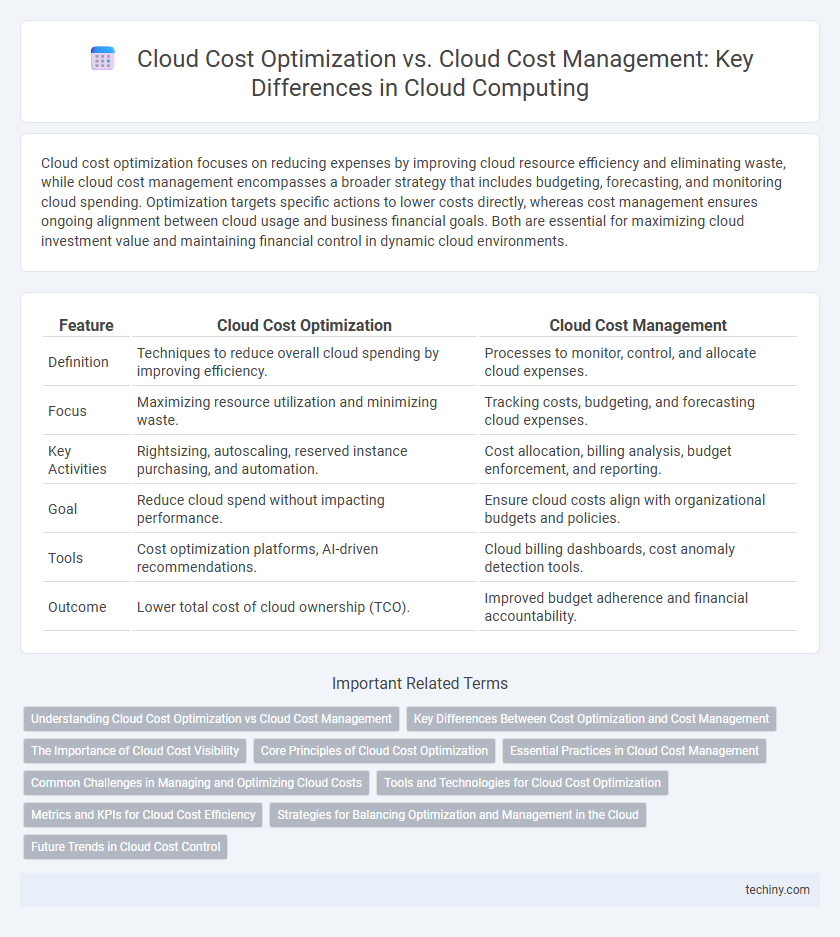Cloud cost optimization focuses on reducing expenses by improving cloud resource efficiency and eliminating waste, while cloud cost management encompasses a broader strategy that includes budgeting, forecasting, and monitoring cloud spending. Optimization targets specific actions to lower costs directly, whereas cost management ensures ongoing alignment between cloud usage and business financial goals. Both are essential for maximizing cloud investment value and maintaining financial control in dynamic cloud environments.
Table of Comparison
| Feature | Cloud Cost Optimization | Cloud Cost Management |
|---|---|---|
| Definition | Techniques to reduce overall cloud spending by improving efficiency. | Processes to monitor, control, and allocate cloud expenses. |
| Focus | Maximizing resource utilization and minimizing waste. | Tracking costs, budgeting, and forecasting cloud expenses. |
| Key Activities | Rightsizing, autoscaling, reserved instance purchasing, and automation. | Cost allocation, billing analysis, budget enforcement, and reporting. |
| Goal | Reduce cloud spend without impacting performance. | Ensure cloud costs align with organizational budgets and policies. |
| Tools | Cost optimization platforms, AI-driven recommendations. | Cloud billing dashboards, cost anomaly detection tools. |
| Outcome | Lower total cost of cloud ownership (TCO). | Improved budget adherence and financial accountability. |
Understanding Cloud Cost Optimization vs Cloud Cost Management
Cloud Cost Optimization focuses on reducing unnecessary expenses by enhancing resource efficiency, leveraging automation, and selecting cost-effective services within cloud environments. Cloud Cost Management involves monitoring, controlling, and forecasting cloud expenses to align spending with budgetary goals and organizational priorities. Understanding the distinction between these two enables businesses to implement effective strategies that balance cost savings with operational performance in cloud computing.
Key Differences Between Cost Optimization and Cost Management
Cloud Cost Optimization focuses on reducing expenses by improving resource efficiency, eliminating waste, and leveraging pricing models such as reserved instances or spot instances. Cloud Cost Management encompasses broader financial governance, including budgeting, forecasting, monitoring, and reporting to ensure cloud spending aligns with organizational goals. Key differences lie in Cloud Cost Optimization targeting tactical expense reduction strategies while Cloud Cost Management delivers strategic oversight and continuous financial control over cloud investments.
The Importance of Cloud Cost Visibility
Cloud Cost Optimization hinges on actionable insights derived from comprehensive cloud cost visibility, enabling organizations to identify underutilized resources and optimize expenditures. Cloud Cost Management encompasses ongoing processes that monitor, analyze, and control cloud spending, but without clear cost visibility, strategic decisions remain uninformed and ineffective. Enhancing cloud cost visibility through advanced analytics and real-time reporting is essential for both optimizing costs and maintaining effective financial governance in cloud environments.
Core Principles of Cloud Cost Optimization
Cloud Cost Optimization emphasizes maximizing cloud resource efficiency while minimizing expenses through continuous monitoring, right-sizing, and eliminating wasteful spending. Core principles include workload analysis, leveraging automation for scaling, and choosing cost-efficient pricing models to align consumption with actual needs. This approach ensures financial accountability and operational agility in dynamic cloud environments.
Essential Practices in Cloud Cost Management
Cloud cost optimization focuses on reducing cloud expenses through efficient resource usage, while cloud cost management encompasses monitoring, analyzing, and controlling cloud spending to align with business goals. Essential practices in cloud cost management include continuous usage tracking, implementing budgeting and forecasting tools, and establishing governance policies to prevent overspending. Leveraging automated tools and detailed reporting ensures transparency and timely adjustments in cloud resource allocation.
Common Challenges in Managing and Optimizing Cloud Costs
Managing and optimizing cloud costs frequently involves challenges such as lack of real-time visibility into resource usage, inefficient allocation of cloud resources, and the complexity of pricing models across multiple cloud providers. Cloud cost optimization focuses on continuously refining resource utilization to reduce unnecessary expenses, while cloud cost management encompasses broader processes including budgeting, forecasting, and governance to control overall spending. Addressing these challenges requires implementing automated monitoring tools, leveraging predictive analytics, and establishing clear policies to maintain cost efficiency and prevent budget overruns.
Tools and Technologies for Cloud Cost Optimization
Cloud Cost Optimization focuses on using advanced tools like AWS Cost Explorer, Azure Cost Management, and Google Cloud's Cost Management suite to identify inefficiencies and reduce cloud spending by leveraging automation and machine learning algorithms. Cloud cost optimization tools integrate with cloud platforms to provide real-time monitoring, predictive analytics, and resource rightsizing recommendations that help organizations eliminate waste and improve ROI. In contrast, Cloud Cost Management encompasses broader governance, budgeting, and policy enforcement strategies but relies heavily on these specialized optimization technologies for actionable cost-saving measures.
Metrics and KPIs for Cloud Cost Efficiency
Cloud Cost Optimization concentrates on improving specific metrics like Cost Per User, Resource Utilization Rate, and Savings Potential to maximize cloud expenditure efficiency. Cloud Cost Management encompasses broader KPIs such as Total Cost of Ownership (TCO), Budget Variance, and Forecast Accuracy to maintain long-term financial control. Tracking these metrics ensures actionable insights for reducing waste and aligning cloud spending with business objectives.
Strategies for Balancing Optimization and Management in the Cloud
Cloud cost optimization focuses on reducing expenses by identifying underutilized resources and leveraging reserved instances or spot pricing, while cloud cost management emphasizes ongoing monitoring, budgeting, and governance to control spending. Strategies for balancing optimization and management include implementing automated cost analysis tools, establishing clear policies for resource usage, and integrating real-time alerts to prevent budget overruns. Combining granular cost visibility with strategic resource allocation enables organizations to maintain financial discipline without compromising cloud performance or scalability.
Future Trends in Cloud Cost Control
Cloud cost optimization focuses on reducing expenses by improving resource usage and efficiency, while cloud cost management encompasses broader strategies including budgeting, monitoring, and governance. Future trends in cloud cost control emphasize increased automation through AI-driven analytics, real-time cost visibility, and integration of multi-cloud expense models. Advanced predictive tools will enable proactive budgeting and dynamic scaling, driving smarter financial decisions within cloud environments.
Cloud Cost Optimization vs Cloud Cost Management Infographic

 techiny.com
techiny.com